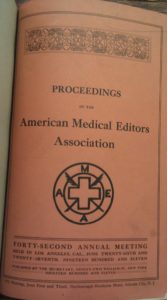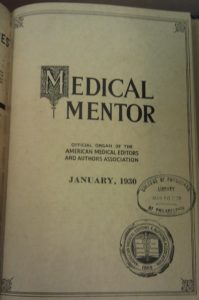– by Wood Institute travel grantee Jennifer J. Connor, PhD*
A journal has demands that never cease – a perpetual machine, it requires constant attention and lubrication. The metaphor of a machine seems obvious to me – applicable to any small scholarly journal that I have edited, even with the advent of online access – so I was fascinated that early medical journals adopted a ‘life cycle metaphor’ to personify journals as organisms that lived from birth to death. Here, the exhaustion of their “parent-surrogate” editors was seen as the main reason that journals ceased to exist.[1] I decided to expand my historical research on medical print culture in North America, and the centrality of Philadelphia[2], to learn more about medical editors and the professionalization of that role.
The metaphor of the human body made sense to physicians to describe the earlier realm of publishing printed journals. Since contemporary medical journals are large operations involving many staff with demonstrable impact and extensive resources, something must have changed. I wondered: What was the editor’s role in the change? Medical journal editors are, and were, usually outspoken, often provocative, and typically leaders who goaded for change in medicine. What did they make of their own occupation? What did it mean to be a medical journal editor? What changes did they seek to their role? What did they do to unite?
Preliminary study indicated that in twentieth-century North America, editors acquired a separate professional identity, changing their role from part-time physician-editor/some time proprietor to full-time, paid employee. The American Medical Editors’ Association (AMEA), established in 1869, exemplified an attempt to organize and upheld the view that journal editorship was a distinct medical specialty. By the early twentieth century, the AMEA had hundreds of North American members, and reports of its annual meetings, key papers, and presidential addresses appeared in medical journals. Yet no one has studied this somewhat forgotten society and its activities, let alone examined its role in the professionalization of medical editorship.[3]
Under AMEA president James Evelyn Pilcher from Carlisle, Pennsylvania, the society published its transactions between 1906 and 1911, and so examining them was crucial to understanding the activities of the AMEA and by extension those of North American medical editors. The Historical Medical Library of the College of Physicians of Philadelphia (“College”) holds the only known copies of this publication, the Proceedings of the American Medical Editors’ Association, along with its two successors, the Journal of the American Medical Editors’ Association (1913-1925?), and Medical Mentor (1929-1933?).
A welcome F.C. Wood Institute for the History of Medicine travel grant supported my return to the College for this research. I conducted extensive work at the College in another millennium (really – the 1990s) for my study of the Medical Library Association, a physician-led society to improve medical libraries that had been established in Philadelphia in 1898 by ophthalmologist George M. Gould.[4] Dr. Gould was a renowned medical editor, so the connections between the two topics were closely entwined. Among Gould’s many roles, in 1895 he became president of the AMEA. At the time, Gould was editor of Medical News. There, and through his editorship of two later medical journals (Philadelphia Medical Journal and American Medicine), he wrote obsessively and influentially about the evils that beset medical journals.[5]
I subsequently developed graduate courses in Philadelphia on the history of medical publishing. I incorporated visits to the College into these courses, enabling students to work with primary sources. While of significant value for teaching and learning, this activity also reinforced the degree to which the College collections are unique. As I anticipated, my recent visit from Canada uncovered more material for my current research than I could discern even through online catalogues.
The first find – important for library cataloguing though initially disappointing to me as researcher – was that there are not 42 volumes of the AMEA proceedings. Rather, someone evidently inferred this total number from the numbers assigned to the annual meetings of the society (for instance, the first volume in 1906 published the proceedings of the 37th annual meeting of AMEA in Boston).
Holding the actual book-form transactions in my own hands confirmed that it was beautifully produced, a ‘handsome booklet’ as Pilcher had said in his 1907 presidential address. (Fig. 1) Seeing the Journal in magazine format ‘in place of the old and useless bound transactions,’ according to the society’s secretary in 1914, demonstrated how dramatically the society changed under different leadership, as the material form of its official organ reflects steps in professionalization from publication as record to publication as communication.
The AMEA Journal and Medical Mentor (which ironically returned to book form) (Fig. 2) amply filled gaps in my study. Calls for collective action among editors rejuvenated the AMEA under Pilcher as president. The society’s activities also illustrate concerns that resonate to the present, including the insertion of commercial interests into the medical journal, as well as the role of editor. I had earlier traced the AMEA until the 1920s, but I now know how it became inactive and how it re-emerged as a larger group incorporating authors. Medical Mentor shows how the group then lost focus as it catered to physicians’ hobbies, or as the Journal of the American Medical Association (JAMA) observed in 1931, ‘to lucubrations on literary topics.’
By examining the College library’s two card catalogues onsite, I discovered American Medical Journalist, an earlier journal published from 1897 to 1907. (Fig. 3) In 1906, this journal explained that it had been the official organ of the AMEA until 1902, while it also included the work of the American Medical Publishers Association (established 1893). By 1906, however, it turned into a serialized pamphlet for attacking the AMA, JAMA, and JAMA’s editor, George Simmons.

My examination of the AMEA’s actual activities through these journals has already proved invaluable to my larger study. It reveals how much success the society achieved, while also explaining the reasons it slipped into historical oblivion sometime in the 1930s. It also indicates why it would take another fifty years for medical editors to unite to develop international guidelines of publishing in medicine; to begin research into their field of endeavor; and to establish training and continuing education of editors.
Endnotes
[1] Jennifer J. Connor, ‘Publisher ownership, physician management: Canadian medical journals in the Victorian Era,’ Victorian Periodicals Review 34 (4) (2010): 388-428.
[2] Jennifer J. Connor, ‘Stalwart giants: medical cosmopolitanism, Canadian authorship, and American publishers,’ Book History 12 (2009): 210-39.
[3] But Patricia K. Woolf referred to it in her essay ‘“Without Truckling or Pandering”: The Professionalisation of Medical Editing,’ in Stephen P. Lock, ed., The Future of Medical Journals: In Commemoration of 150 Years of the British Medical Journal (London: British Medical Journal, 1991), 36-52.
[4] Jennifer Connor, Guardians of medical knowledge: the genesis of the Medical Library Association (Lanham, MD: Medical Library Association and Scarecrow Press, 2000).
[5] Jennifer J. Connor, ‘Writing medicine: George M. Gould and medical print culture in Progressive America,’ in Science in Print: Essays on the History of Science and the Culture of Print, ed. Rima D. Apple, Gregory J. Downey, and Stephen L. Vaughn (Madison: University of Wisconsin Press, 2012), 107-29.
*Jennifer J. Connor is Professor of Medical Humanities in the Faculty of Medicine, cross-appointed to the Department of History, at Memorial University of Newfoundland. She received an F.C. Wood Institute Travel Grant from the College of Physicians of Philadelphia in 2015.


